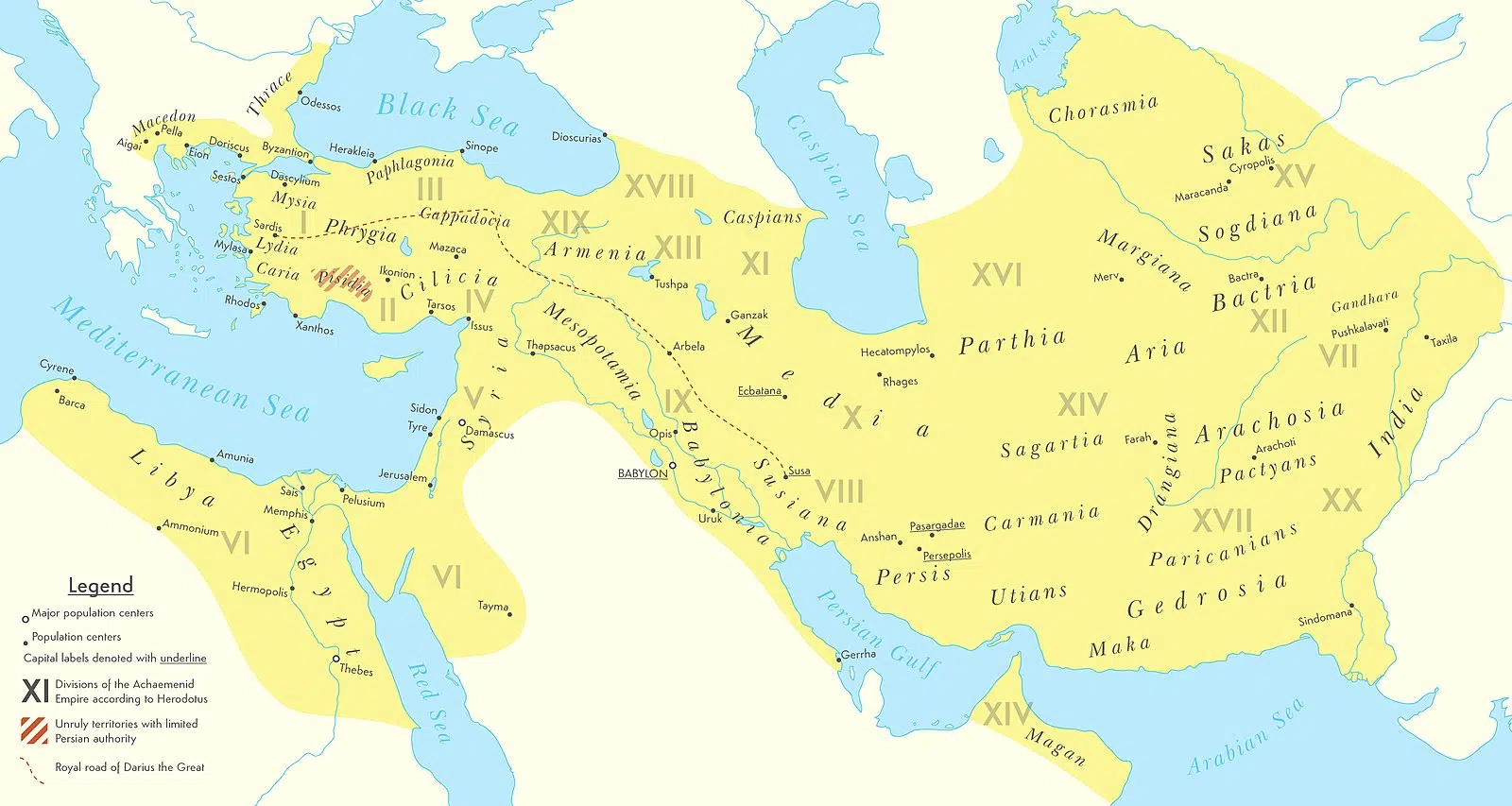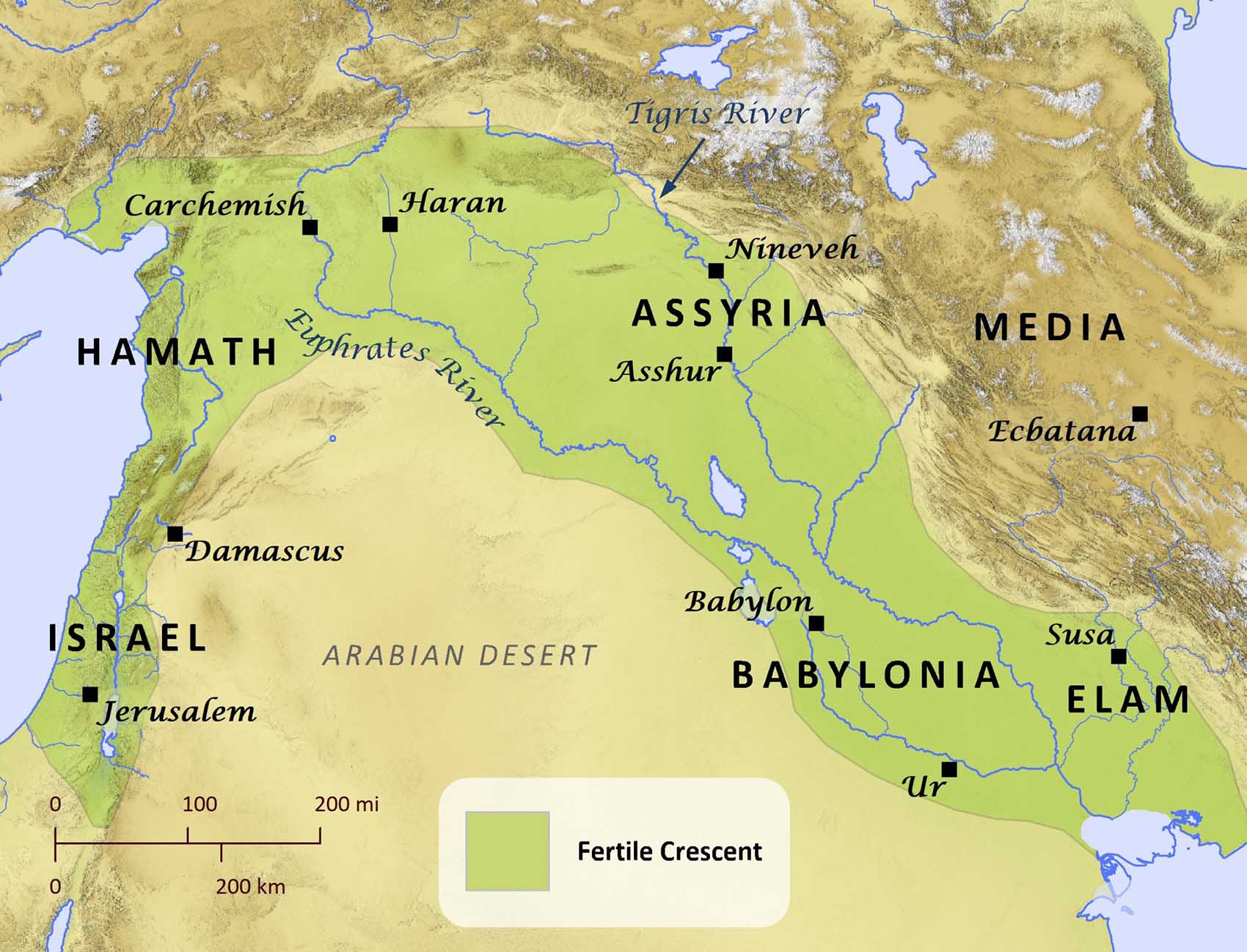The Vision of the Ram and the Goat:
A goat flies from the west. It has a huge horn between it eyes. It attacks the ram with rage, breaking the ram’s horns, and trampling it to death. The goat glorifies itself, but its horn breaks, and four other horns grow from its head.
In Chapter 8, Daniel is witnessing another vision. In his vision, he is standing beside the Ulai Canal in Susa, one of the cities of the Babylonian empire during the reign of Belshazzar, who was Nebuchadnezzar’s grandson. A ram appears beside the canal. He has two horns, and one horn is longer than the other. He begins kicking and bucking about so wildly that no other beasts can stand in his way. No one can stop him. He is both powerful and vain. We will find out later that the ram represents the Medo-Persian empire.
Yet while Daniel was observing the ram, behold, he sees a male goat appear. The goat came from the west over the surface of the whole earth without touching the ground. This new animal is so swift that it moves across the ground without touching it; it is a flying goat. Daniel notes that there is a conspicuous horn between the goat’s eyes. A large, prominent horn.
A brief battle takes place. The goat moves beside the ram, and he was enraged at him. Not only does the goat challenge the ram, but he has intense anger toward him. Daniel writes that the goat struck the ram and shattered his two horns, and the ram had no strength to withstand him.
With one strike, the flying goat defeats the ram. The ram’s uneven horns are shattered, broken into many small pieces. The ram does not put up much of a fight, having no strength to defend itself. After breaking his rival’s horns, the goat hurled the ram to the ground and trampled on him, and there was none to rescue the ram from his power. Victorious, it is the goat’s turn to glorify himself. Daniel saw that the male goat magnified himself exceedingly just as the ram had “magnified himself” earlier after its own conquest (v.4).
This moment of celebration by the goat is short-lived, it seems, because as soon as the goat was mighty, the large horn was broken; and in its place there came up four conspicuous horns toward the four winds of heaven.
Nothing external breaks off the large horn. It simply breaks on its own. Four other horns take its place, growing in four directions, to the north, east, south, and west.
An angel will explain this vision to Daniel later in the chapter. We will learn that
“The shaggy goat represents the kingdom of Greece, and the large horn that is between his eyes is the first king. The broken horn and the four horns that arose in its place represent four kingdoms which will arise from his nation, although not with his power.”
(Daniel 8:21-22)
This is fulfilled by Alexander the Great of Macedon (northern Greece), who led an army from the west and conquered the Persian empire beginning in 334 BC, several years prior to the death of Darius III (330 BC), moving across the surface of the whole earth to take control of modern-day Turkey, Egypt, the Middle-East, and part of India.
In the vision, the male goat representing Alexander flies through the air, moving over the earth, not on it, without touching the ground. This depicts how Alexander’s conquest was carried out in an astoundingly short time period, roughly thirteen years to capture 2 million square miles of various kingdoms and nations. Nor did Alexander ever lose a battle (see map on sidebar).
The male goat destroys the uneven ram in brutal fashion, as if vengeful. The goat (Greece) was enraged at the ram (Medo-Persia). This seems to be representative of Greece’s hatred toward the Persian Empire at the time. Darius the Great (reign. 522-486 BC) invaded parts of Greece and established vassals there, but eventually these Greek city states would defy Persian rule. The Greeks rebelled, and regained independence, but were obliged to fight wars of resistance off and on over a fifty year time period (492–449 BC). Persia tried to invade and conquer Greece twice in 490 and 480 B.C.
The first Greco-Persian war ended at the battle of Marathon in 490 BC. Darius returned to Persia to plan a failed follow-up invasion, but died soon after.
The new king, Darius’s son Xerxes, began the second Greco-Persian war ten years later in 480 BC. This second war involved the famous battle of Thermopylae against the 300 Spartans, commanded by King Leonidas, where the Spartans held back the Persians for several days, yet would ultimately be slaughtered. Leonidas’ body was desecrated, beheaded and crucified, by the wrathful Xerxes.
Xerxes would successfully conquer and hold Greek territory for the following year, but ultimately would be driven back east after his forces were defeated at the battle of Plataea (479 BC). From then on, the Greeks were no longer on the defensive against the mighty Persian empire, and were able to focus their resources on accumulating strength, no longer having invaders to fend off. An alliance known as the Delian League was formed to gain a foothold in Asia Minor and fight remnants of the Persian presence there for the next near-thirty years (478 BC – 449 BC).
Over a hundred years later, the Greeks still despised and resented the Persians. In 334 BC, Alexander the Great would begin his campaign to conquer Persia, in part to avenge the Greek people for Xerxes’ invasion in 480 BC.
This is likely why in Daniel’s vision, the goat was enraged at the ram. The goat not only defeats the ram, but fights with passion, vengeance, and excessive destructive force: and he struck the ram and shattered his two horns, and the ram had no strength to withstand him. So he hurled him to the ground and trampled on him, and there was none to rescue the ram from his power. Nothing could stop Alexander’s conquest. At the time of Alexander’s invasion, Persia was weakened by civil wars and an ineffective, unpopular king, Darius III. Persia had no strength to withstand Alexander, and was subsequently hurled to the ground and trampled. Darius III was slain in 330 BC, meaning that Alexander’s conquering of Persia was, indeed, lightning fast, as represented in Daniel’s vision.
Alexander magnified himself exceedingly (Daniel 8:8). He claimed to be descended from Greek heroes such as Heracles, as well as the son of Zeus himself. But, just as God revealed to Daniel, as soon as he was mighty, the large horn (Alexander) was broken; and in its place there came up four conspicuous horns toward the four winds of heaven. Alexander began his reign at age 20, but died at the young age of 32 in Babylon. Alexander was mighty indeed, the new Emperor of the middle-eastern and western world, and as soon as so mighty—then broken and dead. It is speculated that he succumbed to typhoid fever. In the ancient world, when men died of illness, it was often ascribed to being the hand of God that killed them, since no hand of man struck them down. Regardless, God is sovereign over all of these events, these empires rising and falling.
Now that the large horn was broken, civil war erupted. Alexander’s dominion plunged into division: in place of the large horn grew up four conspicuous horns. Alexander’s generals battled to rule his lands in the Wars of the Successors, ultimately ending with four men claiming four regions to rule toward the four winds of heaven, four pieces of Alexander’s pie.
Ptolemy took Egypt, Antigonus took Asia-Minor (modern-day Turkey), Cassander was king of Macedon (Northern Greece), and Seleucus ruled much of the Middle East. These were the four horns on the male goat, four kingdoms which grew from the power vacuum left after the large horn, Alexander, was broken. The Seleucid kingdom which sprang from the reign of Seleucus will play a prominent and prophetic role in Israel’s future.
Biblical Text
5 While I was observing, behold, a male goat was coming from the west over the surface of the whole earth without touching the ground; and the goat had a conspicuous horn between his eyes. 6 He came up to the ram that had the two horns, which I had seen standing in front of the canal, and rushed at him in his mighty wrath. 7 I saw him come beside the ram, and he was enraged at him; and he struck the ram and shattered his two horns, and the ram had no strength to withstand him. So he hurled him to the ground and trampled on him, and there was none to rescue the ram from his power. 8 Then the male goat magnified himself exceedingly. But as soon as he was mighty, the large horn was broken; and in its place there came up four conspicuous horns toward the four winds of heaven.
Check out our other commentaries:
-
Hosea 9:10-14 meaning
Hosea tells Israel that although He was pleased with her in her youth, her disobedience and devotion to Baal worship and its attending culture of...... -
Colossians 1:15-20 meaning
Paul lays out the far-reaching supremacy of Christ. From beginning to end, in life and death, Jesus is preeminent in all things....... -
Hebrews 13:15-16 meaning
We have the opportunity to offer up sacrifices better than animals to God, through our praise. ...... -
Genesis 7:6-14 meaning
Noah was 600 years old when the flood came. There were eight people, and a male and female of every kind of animal on the...... -
Matthew 5:38-42 meaning
Jesus flips the world system of ‘justice’ on its head. He tells His disciples to seek out opportunities to serve rather than looking for opportunities......




